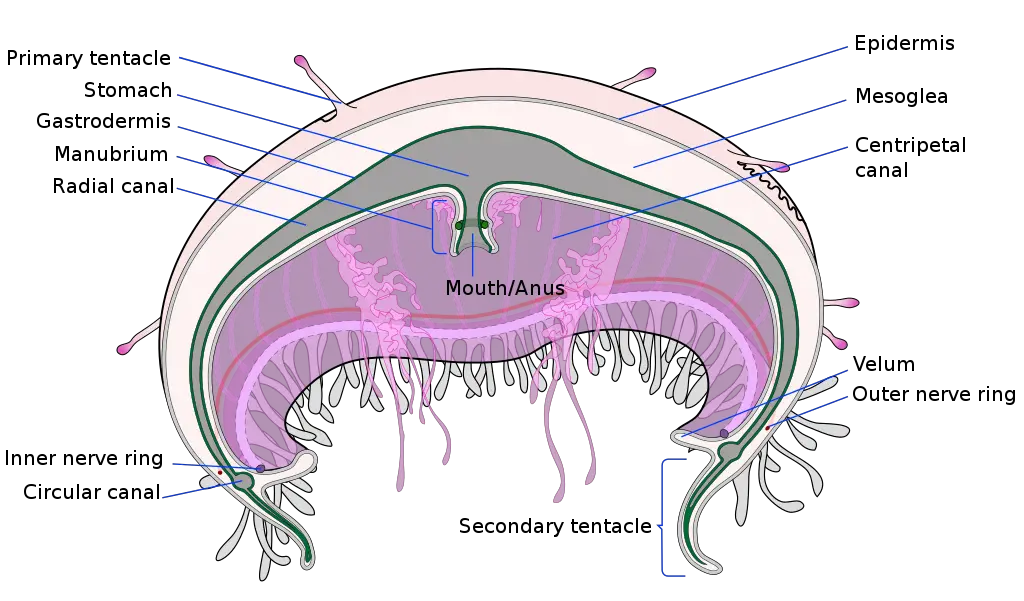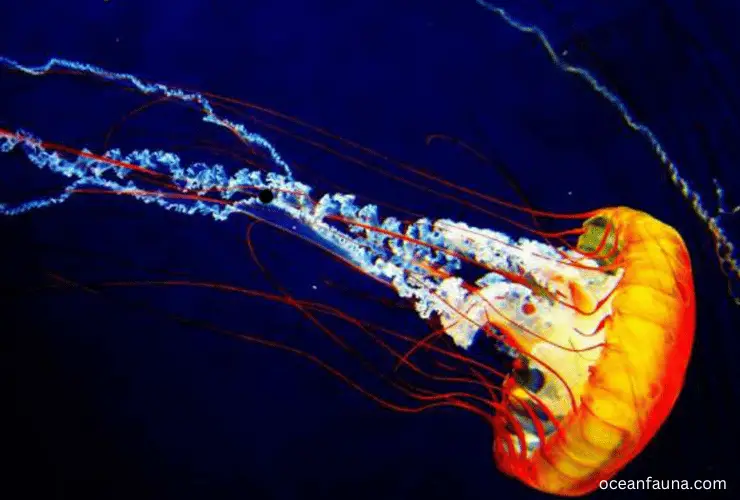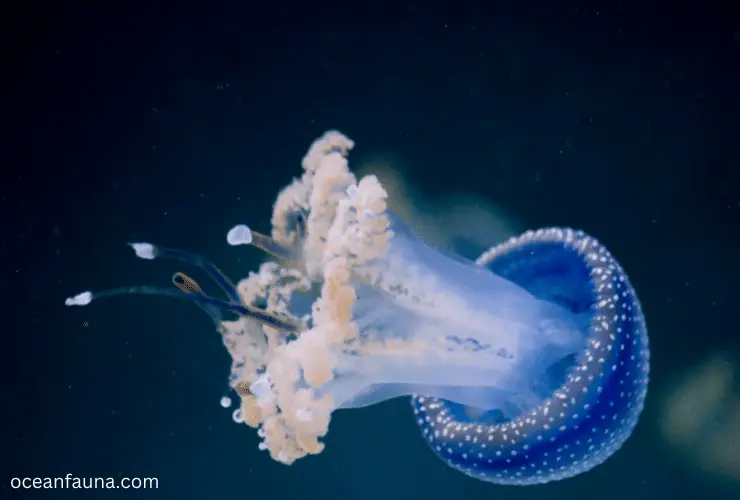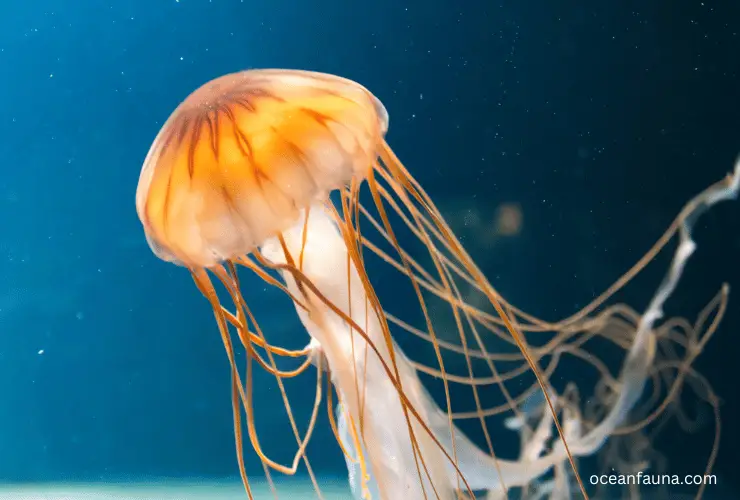No, Jellyfish don’t have gills or any specific organs that solely help in breathing or inhaling oxygen. Instead, the thin tissue layer over the bell helps a jellyfish absorb oxygen from the seawater. You can find 2000 scientifically certified jellyfish species across the world, and none of them has gills, brains, or hearts.
The “Umbrella” shaped top body of the jellyfish is known as the bell. It contains only two tissue layers apart from the mesoglea. And the amount of oxygen tissue membranes catch is quite enough for the jellyfish body. For this reason, Jellyfish don’t have gills or lungs, even if they’re called “fish.”
Do Jellyfish Have Gills or Lungs?
Mother nature is quite fair with every being on this planet. You could barely see any creature with an unwanted structure or organ living well. The body mechanism of jellyfish doesn’t require gills, brain, or heart. They don’t even have blood inside their body.
If you focus deep into the jellyfish anatomy, you’d understand that jellyfish don’t have too many specified organs. Apart from tentacles, the whole umbrella-shaped structure is known as a bell. So, jellyfish don’t need blood to circulate oxygen or food values throughout the whole body. And for that reason, they also don’t have any heart.

As for breathing, the mesoglea between the two bell layers helps to collect oxygen from the water and transfer it inside through the gastrodermis layer. Due to not having too many constantly active organs, there’s no reason to get support from something like the lungs or gills.
Do Box Jellyfish Have Gills?
Box jellyfish have very dangerous and venomous tentacles to hunt down prey and live on them. That’s why few people might think that a box jellyfish can have unique anatomy than other jellyfish species.
But in reality, they also don’t have any gills. They consume and store oxygen through their skins. Although box jellyfish can swim and move better, they don’t need any respiratory organ to hold their breath for a longer movement.
Do All Jellyfish Have Gills?
No jellyfish species has gills or lungs.
The movement of jellyfish is generally known as locomotion. Any being with multiple specified organisms can’t perform locomotion to squeeze and push their body to move forward. Because of this, jellyfish have no separate consumption and waste-ejecting organs also.
The biological mechanism of jellyfish or similar species’ bodies is to contain a minimum number of organs and parts so that the posture doesn’t stay stiff and allows it to bend in any way desired for free movement. So, jellyfish having no respiratory organ and yet living is nothing to be getting confused about.
What is Respiration?
Normally, respiration means the breathing of every living being. This is actually true at some points, but this term has some broad matters inside.
Respiration is the process where a being’s live cells collect oxygen from any outer source to get the oxygen involved with multiple food values to create energy. The last step of the whole respiring thing is ejecting or exhaling the carbon dioxide created from the previous reactions as waste.

According to several scientific journals, respiration is the total movement of the air taken inside a creature’s body to gain ATP or energy. Most vertebrate species have specified organs to respire consecutively till death.
Humans and many other mammals have lungs for respiration, whereas fishes and other beings underwater have gills that work exactly like lungs to ensure consistent breathing.
Do Jellyfish Respire?
In a way, jellyfish do respire. But the respiration system of jellyfish and other creatures having body structures like gelatin have different ways to breathe as they don’t have any respiring organs.
Jellyfish is the only fish by the name. They don’t have gills. But the cells in the bell area are enough to collect oxygen from the water and create energy to live. In short, they respire and breathe but without any breathing system.
Respiration mainly has two phases. The first phase is to absorb water or air. And the next step is to diffuse oxygen from the source to pass oxygen for further reactions.
Because of having very thin tissue layers. There’s no need to absorb or gather water. The water easily gets soaked in the tissues and the oxygen becomes quickly diffused. That’s why the jellyfish can breathe despite having no gills.
How Do Jellyfish Breathe?
We’ve previously said that jellyfish follow a respiration system that seems more like a general oxygen diffusion process. Thus, you can also say that jellyfishes diffuse to breathe underwater.
Now, the question is, can the amount of oxygen produced by the tissues be enough for a whole jellyfish body? The answer is yes. Apart from the epidermis and gastrodermis layers, the main layer remaining in the bell area (the main body except for the tentacles) is the mesoglea. The gelatin-like mesoglea has mostly elements that don’t need oxygen.
Excluding mesoglea, the epidermis and gastrodermis layers are mainly most of the bell area. As the tissues directly perform cell respiration or diffusion, they don’t require any other organs to collect the oxygen source. The cells automatically diffuse oxygen from the water whenever required.
Are Gills Like Lungs?
Obviously, gills are like lungs. Both organs help to inhale and exhale. The key purpose of gills and lungs is to collect the oxygen source and release the remaining air or water along with carbon dioxide into the environment.
But in reality, the job of gills is pretty tough. A unit of water has 50 thousand times less oxygen than a unit of air. Although small fishes or other beings don’t need too much oxygen, the ratio still makes the whole scenario pretty rough.

Besides, gills remain near the water, the only oxygen source for creatures. And lungs are connected with a co-organ directly dealing with the air; for example, the nose and mouth.
Ultimately, the function of the gills and lungs is almost the same. The noticeable differences are how they collect the oxygen source and what type of environment they’re in.
FAQ
Do jellyfish have lungs?
Jellyfish don’t have lungs or other organs dedicated to breathing and respiring. Jellyfish bodies have tissues that are enough to collect oxygen to live. That’s why they don’t depend on any breathing organ.
Do jellyfish have a respiratory system?
No jellyfish species has a specified respiratory organ. Instead, they depend on their bell tissues to diffuse oxygen for their bodies. Specifically speaking, jellyfish depend on cellular respiration.
Do jellyfish need oxygen?
Jellyfish do need oxygen to live. Any living being underwater needs oxygen to live and create energy from food. Despite not having any gills or lungs, jellyfish breathe and live.
Summary
Long story short, jellyfish don’t have lungs, and yet, they can breathe properly. The absence of gills doesn’t put the jellyfish family at any disadvantage. Instead, having fewer organs help the so-called fish to move and live accordingly.
If you believe in the big bang theory, then you should know that jellyfish lived even before the dinosaur age.
Till now, the environment or ecosystem of the sea hasn’t changed much for jellyfish. Thus, they can breathe naturally underwater beside the evolved vertebrate and mammal species.


1 thought on “Do Jellyfish Have Gills or Lungs? Scientific Facts”